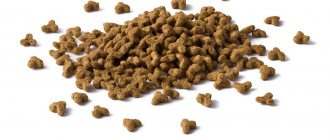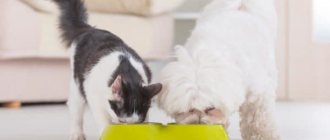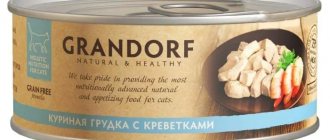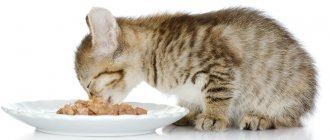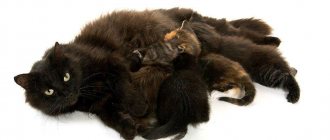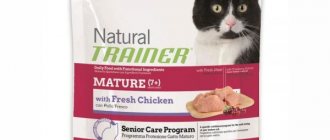Protein requirements of pets
Dogs and cats are carnivores, and animal protein is one of the key elements in their diet. The physiology of our pets has been well studied, and the biological needs of their body, including protein, are clearly defined. Adult dogs require 4.5-6.0 g per kilogram of weight, and with increased loads - up to 9.0 g. For cats, which are obligate predators, these figures are even higher: 5.3-6.3 g, maximum - up to 10 g (at high activity).
Let's take as an example one of our brand's food - Acana Grasslands Dog dry food, which contains 35% protein. According to the feeding chart on the package, an adult active dog weighing 20 kg of this diet requires 240 grams per day.
35/100*240 = 84 g - this is how much protein the animal will receive per day;
84:20 = 4.2 g - this is the amount of protein per 1 kg of weight.
As you can see, the food satisfies the adult dog’s body’s need for protein, and accordingly, its content can be considered optimal.
Comparison of cat food types
Keep in mind - the price directly depends on the quality of the food!
Budget food belongs to the economy class. You will instantly recognize them on the shelf, because these foods are actively advertised, are the most widely represented on the market and can be bought in almost any supermarket. Economy class foods include Whiskas, Kitekat, Darling, Friskies, Oscar, Four-Legged Gourmand, etc.
Economy-class food contains many artificial additives (flavor enhancers, dyes and preservatives), but there is offensively little meat. It is intended to replace low-quality offal and vegetable proteins. Such food will never be properly balanced and the differences in the line are only in taste, and not in content. Digestibility of economy class feed is 60-65%.
A higher level is premium food. They are also inexpensive and do not have much meat content. Of those presented in our stores, premium food includes Royal Canin (Russia), Pro Nature, Nutra, Happy Cat, etc.
It is assumed that they contain a little more meat than in the previous class of food, and the by-products are better. In premium food there is already a division according to purpose (kittens - older cats, for hair removal - regular food). Digestibility – 70-75%.
The price of super-premium cat food is already significant for the family budget. These foods are practically not advertised, since it is believed that the reputation of the brands Hills, Royal Canin (France), ProPlan, Nutra Nuggets, etc. speaks for itself. Super-premium food can be purchased exclusively in pet stores and veterinary institutions.
They contain a lot of meat, little vegetable protein, and no artificial additives at all. It is absorbed by 85-95% and already takes into account the breeds of cats.
Our cat “Maslow’s pyramid” is completed with Human Grade (Holistic) food, which can only be purchased by pre-order. Eagle Pack Holistic, Evo, Orijen, Felidae - these are all Michelin stars in your pet's bowl.
Elite food contains plant components, expressed without treatment with harmful substances (including pesticides). Animal sources raised without the use of hormones or antibiotics. By the way, if you wish, you can also try this food together with your pet without harming yourself.
Features of the composition of dry cat food
Leave the myths about the unhealthiness of dry food in the past, because, in fact, the compositions of wet, semi-wet and dry food are the same. The difference is only in proportions.
To understand this, let's imagine how the dry food production process goes.
First, nutritionists develop a recipe. Its components are mixed using automatic machines and this raw material is baked and pressed through “sieves” that determine the future form of dry food. Next comes the decorating process. That is, dried pieces of food are “pollinated” with fat and digestives, which make the dried product more appetizing. These are the main processes for producing dry food.
Therefore, good dry food will not state that the percentage of meat component is too high. According to the law, the manufacturer indicates the share of the final product, and dried meat cannot occupy more than 50%. Normally and usually it is 35%.
If you do not find meat in the first place in the dry food, do not be upset, its weight after drying determines the 4th, 5th, or even 10th place in the composition.
The absence of dyes and flavors means that the food is not harmful to the cat.
In addition to the composition of cat food, it is worth looking at the daily feeding rate. That food is more nutritious for an animal whose manufacturers have stated a low daily intake.
Why shouldn’t healthy animals have reduced protein in their feed?
Protein is one of the most important macronutrients in the diet of dogs and cats - without it, the existence of a living organism is impossible, since it is a building material for tissues and organs, elements of the enzymatic and circulatory systems. Proteins consist of amino acids, of which there are 22 in total. Moreover, some of them are essential, that is, they cannot be synthesized by the body from other substances and must be supplied with food.
Arginine, valine, histidine, isoleucine, leucine, lysine, methionine, threonine, tryptophan and phenylalanine are essential for dogs. For cats, this list is one point longer: their bodies are not able to produce taurine. In terms of its amino acid composition, animal protein is the most complete for carnivores, since only it contains a complete set of these “building blocks of life.”
In the absence of a regular influx of protein compounds, partial destruction of various cellular structures is observed, that is, the body begins to make up for the lack of protein at the expense of its own tissues. The consequences of prolonged protein starvation can be irreversible, which is especially important for puppies and kittens and young animals. A significant decrease in protein in the diet in comparison with the physiological norm causes them to stop growing, reduce body weight to critical levels, and change the chemical composition of bones.
By asking which food contains less protein, the owner wants to protect a healthy pet from the risks of disease, but in reality creates a risk of serious disruptions in the body’s functioning.
Until what age is this food needed?
People often find it difficult to decide when to switch a kitten to adult food. Although everything is simple here. If you stick to one manufacturer's food, then it covers all ages with its products. All you have to do is read the instructions and find out up to what age your kitten food is intended. After this you need to move on to the next age category.
Usually you can switch to adult food after six months. From 8-12 months this definitely needs to be done. At this time, growth is already slowing down: there are no such big jumps as there were in 3-4 months. If you continue to feed an adult cat after a year with kitten food, he runs the risk of becoming fat. After all, food for kittens, as we have already said, is more nutritious. An adult cat doesn't need that much.
Who needs low protein dry food?
Situations where food with a low protein content may be required arise with some serious diseases, for example, chronic renal failure or liver disease, and these are not just regular diets, but special veterinary diets that are only an addition to the drug treatment prescribed by the doctor after diagnosis. accurate diagnosis.
Making a decision on your own that your pet needs to reduce the level of protein in its diet is downright dangerous. Having noticed any changes in your pet’s condition, you should not look for dry food with a low protein content, but contact a specialist, and it is quite possible that problems arise precisely because your dog or cat does not receive enough quality animal protein in accordance with its requirements. physiological needs.
Analysis of the composition of cat food
In what cases is it better to put a jar (bag) of food back on the store shelf?
- If you read that cat food contains cellulose, sugar, caramel and, attention, Propylen glycol. The latter is considered a sweetener, but in fact it is a de-icing agent, which is very harmful to the health of the animal.
- If the food contains E127 (an artificial dye), which often provokes cancer.
- If the composition does not hide a large percentage of by-products. Good offal is good for cats, but often under this name manufacturers disguise such unappetizing things as, say, beef skin or simply waste from slaughterhouses.
- The inscription “meat” does not mean that the food contains meat, but that the manufacturer is trying to hide the true nature of this component. Only if you have a transcript, that is, a detailed list of types of meat, can you count on the fact that your cat will eat a pure product.
- Do not buy food if you see it containing Ethoxyquin, BHA (E320) and BHT (E321). These are artificial antioxidants that can damage the liver, cause depression, seizures, and skin neuroses.
- Chemical preservatives are also not the best food for your cat.
What makes a good cat food?
- Meat will come first in a good food! It must be at least 35%! Beef, chicken, turkey, rabbit or fish are healthy meat ingredients.
- The next component that must be present in the feed is protein. 20% protein is a good number. Egg or milk whites are an excellent natural filler.
- Only 10% comes from high-quality offal.
- Plant fibers needed by cats should not exceed 25% of the composition. Oats, wheat, rice, corn are useful for cats only if the manufacturer does not add them in order to save on meat.
- Additional mineral and vitamin supplements are only a plus for the manufacturer’s karma.
Safe and necessary supplements include:
- ascorbic acid;
- vitamins H, K, B3, I15, B5, B6, B2, B1;
- Calciumoxide, Calcium phosphate, Calciumcarbonat (calcium);
- Calcium pantothenat (vitamin B5);
- chloride, choline chloride;
- cobalt, copper, copper carbonate, copper sulfite, iron sulfite, iron oxides, manganese, zinc and copper;
- the presence of an amino acid such as taurine in the composition is also a good indicator and incentive to purchase food;
- natural antioxidants (vitamins E and C) will not harm your pet.
Summing up
- Dry food with a low protein content, as well as homemade food for dogs and cats, which contains little meat, can harm healthy animals, especially young animals, producers, and working dogs (sled dogs, hunting dogs, service dogs).
- Self-diagnosis and a decrease in protein, a vital nutrient, in the diet are a serious risk of worsening your pet’s health problems.
- Biological compliance is a key principle in the production of Acana and Orijen feeds, which is achieved through quality meat ingredients and optimal levels of animal protein in our feeds.
Nutrient content
If we compare the compositions of food from the same line, we will see that products labeled Kitten are characterized by greater nutritional value. They contain the following content:
- protein;
- vitamins;
- minerals;
- fat
This is necessary to support the growth and development of a young body. In addition, due to the increased fat content, the food is quite high in calories. Consequently, it provides more energy, which nimble kids spend very actively.
Advantages and weaknesses
The main positive quality is the affordable price. It is lower than the cost of premium products of similar declared quality. Felinologists believe that Karmi food has the following disadvantages:
- Lack of reputation. The product has recently appeared on the market. There is no information on the effect of feed on the reproductive abilities of breeding animals and the quality of offspring.
- The manufacturer does not disclose the percentage of components.
- There is confusion in different sources. It is unclear whether the manufacturer included dehydrated salmon fillets or fishmeal in the feed.
- The large volume does not allow the food to be used for one or two pets. May expire. Experienced breeders recommend using food from an opened container for 5-6 weeks. The granules oxidize in air, their taste is lost, and toxic substances accumulate.
Product comparison table
| Name | Animal age, years | Type of feed | Special Needs |
| Royal Canin | For all ages | dry | For different breeds, sterilized, prone to overeating, hyperactive, picky about smell, taste or aroma |
| PurinaProPlan | Kittens, adults | After sterilization, with sensitive digestion | |
| Grandorf | For sterilized cats, pets | ||
| Sheba | Adults (1-6) | wet | No |
| Gourmet Gold | Kittens, adults | ||
| Royal Canin Instinctive | For sterilized and overweight people | ||
| Superpet | For all ages | dry, wet | Kittens up to 3 months, weakened animals |
| Acana | dry | No | |
| Hill's | dry, wet |
| |
| ProNature | dry | For sterilized, domestic, hairball control | |
| Orijen | For sterilized and overweight people | ||
| AATU | Adults (1-6) | No | |
| Kitekat | dry, wet | No | |
| Friskies | Kittens, adults | For sterilized, domestic, hairball control | |
| Whiskas | For all ages | For sterilized |
conclusions
Let's summarize all of the above:
- The main difference between food for kittens and a similar product for adult cats is not the list of ingredients, but their proportions.
- It is better to choose a dry diet for your pet that is appropriate for its age. But if a cat needs increased nutrition (for example, during pregnancy and lactation), kitten food is perfect for her.
- For animals under 12 months of age, Blitz Kitten is a good choice. It contains the optimal amount of macro- and micronutrients necessary for the healthy development and growth of the cat's body.
What is the difference between wet food?
Cat owners often note that their pets are much more willing to eat wet food, and believe that it is much healthier. In fact, there are other reasons for this:
- In nature, cats prefer soft food and almost never eat hard food.
- Cats instinctively choose the food that is most saturated with water.
- Smell. The pate smells much more intense than the crackers.
If you carefully study the composition of dry and wet food, you will see that there are practically no differences in them. But pieces in sauce or pates are healthier for cats in terms of digestion.
When choosing a pate for kittens, you should pay attention to the main component: meat should come first, not meat and bone meal or offal. Wet foods for babies contain large amounts of carbohydrates necessary for growth. But for adult cats, too much carbohydrate will only cause harm.
Don't skimp on pates. The higher the price, the more microelements and vitamins the food contains, which the kitten needs for the proper formation of bones and the functioning of the growing body. Animals older than one year do not need as many nutrients.
Feedback from cat owners
Baby food contains a lot of protein, and excessive protein feeding leads to urolithiasis (urolithiasis).
DoMiSol
https://www.u-mama.ru/forum/family/pets/536729/
On the recommendation of a veterinarian, at one time I tried to feed an old cat with Royal kitten food - Babycat canned food. There were problems with appetite and the gastrointestinal tract, the cat ate practically nothing on its own, but for some reason he ate these canned foods, at first everything was fine. But a week later the cat scratched himself terribly. I compared the compositions with adult foods; for kittens the vitamin content is much higher. Perhaps there was a cumulative effect from some vitamins, an excess of them formed in the body, and an allergy developed. Therefore, the food had to be canceled.
Elisaveta115
https://mauforum.ru/viewtopic.php?f=37&t=79311
Food for kittens is very high in calories and if any of the adults have problems with the gastrointestinal tract, in particular with the pancreas, there is a risk that the pancreas will fly. The main difference between the food is that a young growing organism needs more nutritious food as it is developing, an adult no longer needs such food, it can cause harm and therefore the veterinarian’s recommendation to give baby food to an adult animal is very strange
Burma
https://mauforum.ru/viewtopic.php?f=37&t=79311
If the owner decides to feed the pet with industrial food, then it is worth taking care of the appropriate nutrition for each specific case. In any case, you should not neglect the veterinarian’s recommendations, because each animal is a unique organism that requires a special approach.
Pet food manufacturers label their products for a reason: this or that type of food is developed based on the needs of pets. Kitten food has its own characteristics regarding the size and texture of the granules, as well as the composition of nutrients.
Fructooligosaccharides
Interesting, ironic and a little sad? ⠀ Here we are at the last of the 14 premium cat food ingredients. And the last place in the list of ingredients means the smallest share in the product. Ironically, this ingredient has the maximum nutritional value - 6️⃣ points out of ?. We have never seen such high indicators in this premium food ❗️Well... ⠀ Fructooligosaccharides are a type of healthy prebiotics, fermentable fibers that are not digested in the intestines, but are quickly fermented by the microflora of the colon. They: improve the growth and reproduction of beneficial microflora, improve digestion and strengthen the immunity of animals. ⠀ Due to what? Fructooligosaccharides release volatile fatty acids, an ideal environment for the maintenance and renewal of epithelial cells of the colon wall. Thus, they help the pet’s body maintain balance in the intestines. ⠀ And yet let’s grumble a little. If the manufacturer does not indicate the exact amount of this ingredient, we have no reason to expect that the supplement will actually affect the health of the animal. Therefore... let's look together for those packages that contain all the necessary information.
